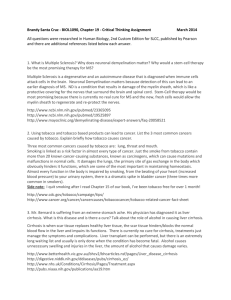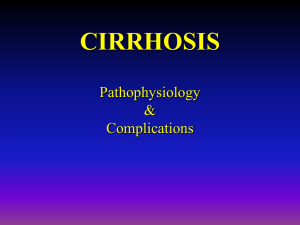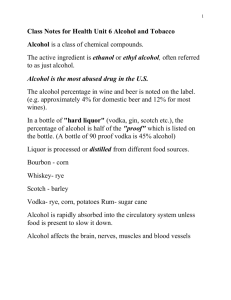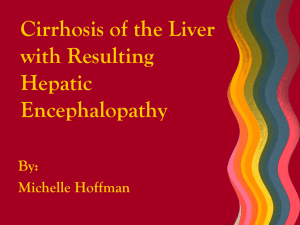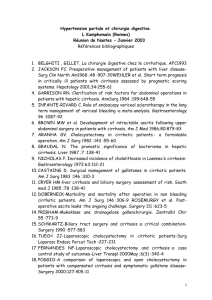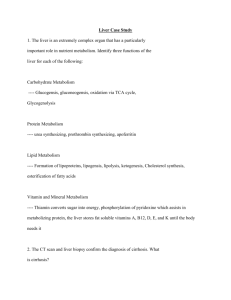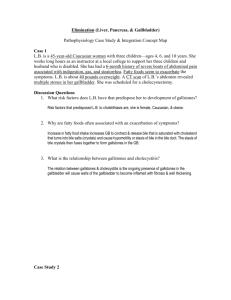File - KNH 411 Medical Nutrition Therapy
advertisement
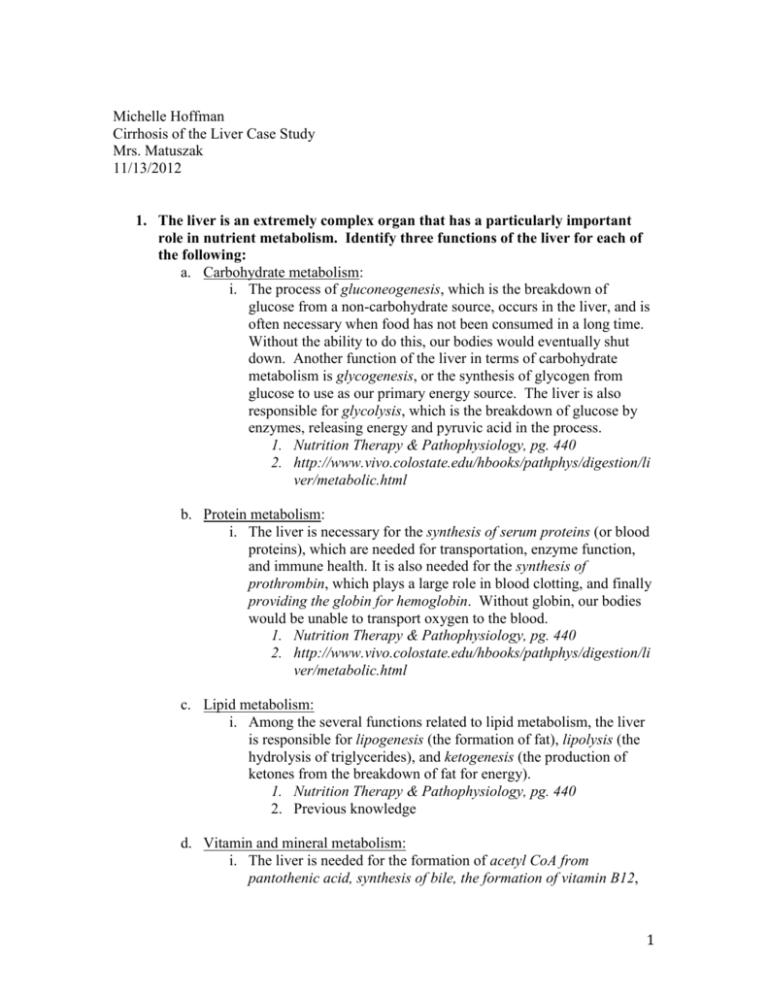
Michelle Hoffman Cirrhosis of the Liver Case Study Mrs. Matuszak 11/13/2012 1. The liver is an extremely complex organ that has a particularly important role in nutrient metabolism. Identify three functions of the liver for each of the following: a. Carbohydrate metabolism: i. The process of gluconeogenesis, which is the breakdown of glucose from a non-carbohydrate source, occurs in the liver, and is often necessary when food has not been consumed in a long time. Without the ability to do this, our bodies would eventually shut down. Another function of the liver in terms of carbohydrate metabolism is glycogenesis, or the synthesis of glycogen from glucose to use as our primary energy source. The liver is also responsible for glycolysis, which is the breakdown of glucose by enzymes, releasing energy and pyruvic acid in the process. 1. Nutrition Therapy & Pathophysiology, pg. 440 2. http://www.vivo.colostate.edu/hbooks/pathphys/digestion/li ver/metabolic.html b. Protein metabolism: i. The liver is necessary for the synthesis of serum proteins (or blood proteins), which are needed for transportation, enzyme function, and immune health. It is also needed for the synthesis of prothrombin, which plays a large role in blood clotting, and finally providing the globin for hemoglobin. Without globin, our bodies would be unable to transport oxygen to the blood. 1. Nutrition Therapy & Pathophysiology, pg. 440 2. http://www.vivo.colostate.edu/hbooks/pathphys/digestion/li ver/metabolic.html c. Lipid metabolism: i. Among the several functions related to lipid metabolism, the liver is responsible for lipogenesis (the formation of fat), lipolysis (the hydrolysis of triglycerides), and ketogenesis (the production of ketones from the breakdown of fat for energy). 1. Nutrition Therapy & Pathophysiology, pg. 440 2. Previous knowledge d. Vitamin and mineral metabolism: i. The liver is needed for the formation of acetyl CoA from pantothenic acid, synthesis of bile, the formation of vitamin B12, 1 and so on. Acetyl CoA plays a key role in producing energy in the body, bile is needed for breaking down fat-soluble vitamins, and the formation of B12 has several functions needed for survival, such as its role in the synthesis of red blood cells. 1. Nutrition Therapy & Pathophysiology, pg. 440 2. http://www.helpguide.org/harvard/vitamins_and_minerals. htm 2. The CT scan and liver biopsy confirm the diagnosis of cirrhosis. What is cirrhosis? a. The twelfth leading cause of death in the U.S., cirrhosis is a serious condition that occurs as the end stage of liver disease. In basic terms, cirrhosis is the replacement of healthy tissue in the liver by scar tissue, which blocks the flow of blood through the liver and can cause kidney failure, enlarged liver, thickening of various tissues, portal hypertension, ascites, and so on. If this condition continues to get worse, patients may need a liver transplant, and nutrition therapy is recommended due to the altered metabolism of nutrients and other resulting complications. 1. Nutrition Therapy & Pathophysiology, pgs. 456-457 2. http://www.nlm.nih.gov/medlineplus/cirrhosis.html 3. The most common cause of cirrhosis is alcohol ingestion. What are additional causes of cirrhosis? What is the cause of this patient’s cirrhosis? a. There are multiple causes of cirrhosis, the most common from hepatitis C, alcoholic liver disease, nonalcoholic steatohepatisis, hepatitis B, cryptogenic causes, cystic fibrosis, Wilson’s disease, autoimmune hepatitis, and so on. Ms. Wilcox is not a chronic alcohol abuser, and the cause of her cirrhosis is most likely from her chronic hepatitis C infection that she was diagnosed with three and a half years ago. i. Nutrition Therapy & Pathophysiology, pg. 458 4. Explain the physiological changes that occur as a result of cirrhosis. a. Cirrhosis alters several physiological functions in the body. As mentioned, the metabolism of carbohydrates, fat, protein, and vitamins/minerals are altered to the point where malnutrition is a serious concern. In addition, a patient with cirrhosis may develop edema/ascites, esophageal varices, have cardiac and vascular changes, hepatic encephalopathy, and/or hepatorenal syndrome. Ascites is the buildup of fluid, and will occur particularly in the legs and abdomen, and this may lead to a bacterial infection or worse. Excessive fluid intake of sodium intake may worsen this complication. Esophageal varices are enlarged blood vessels in the esophagus (result of portal hypertension), and if the pressure is too high, they may burst causing severe bleeding. Hepatic encephalopathy is the buildup of toxins in the brain because the liver is unable to remove toxins from the blood, which can be the cause of death in these patients. Jaundice is another change that may occur because the 2 liver is unable to remove to bilirubin from the blood. Finally, hepatorenal syndrome causes rapid kidney deterioration, and usually fatal. i. Nutrition Therapy and Pathophysiology, pg. 459 ii. http://digestive.niddk.nih.gov/ddiseases/pubs/cirrhosis/ 5. List the signs and symptoms of cirrhosis, and relate each of these to the physiological changes discussed in question 4. a. People with cirrhosis often experience weakness, fatigue, loss of appetite, nausea, vomiting, weight loss, jaundice, abdominal pain and bloating, high blood pressure (portal hypertension), low blood pressure, itching, bruising and bleeding, and spider-like blood vessels on the skin. The weakness and fatigue may be due to a number of things that are all a result of loss of liver function. The bloating is most likely due to the ascites and edema due to the fluid buildup in the system, the weight loss/loss of appetite may be from decreased appetite also related to the loss of liver function and its from in metabolism, and high blood pressure would be a result of portal hypertension from the esophageal varices—these varices make it difficult to swallow as well, thus further contributing to weight loss. Bruising and bleeding may be a result of the inability of the liver to synthesize protein clotting factors. i. Nutrition Therapy and Pathophysiology, pg. 458 ii. http://digestive.niddk.nih.gov/ddiseases/pubs/cirrhosis/ 6. After reading this patient’s history and physical, identify her signs and symptoms that are consistent with the diagnosis. a. Ms. Wilcox has reported feeling very weak and fatigued, is experiencing anorexia, jaundice, bruising, losing weight rapidly, and enlarged veins. To note, her bilirubin levels are extremely high (approximately 3 mg/dL too high), which explains why she has slight jaundice of the skin. IN addition, he blood pressure read 102/65 mmHg, revealing that it is lower than usual and may lead to a diagnosis of hypoglycemia. 7. Hypoglycemia is a symptom that cirrhotic patients may experience. What is the physiological basis for this? Is this a potential problem? Explain. a. Hypoglycemia develops in cirrhosis patients rather commonly as a complication of septic shock. It occurs because the liver is unable to store enough energy in the form of glycogen. Because the body is not able to break down carbohydrates for energy quickly, one should eat small frequent meals rich in complex carbohydrates such as whole grains. Although unregulated hypotension is dangerous, this is not a huge problem for cirrhosis patients. i. http://www.ncbi.nlm.nih.gov/pubmed/7283559 8. What are the current medical treatments for cirrhosis? Although this is a treatable condition, the damage cannot be fully reversed, yet by treating the symptoms, one can prevent cirrhosis from getting worse. Since alcohol 3 consumption is one of the primary causes, one must abstain from consuming any type of alcohol for life. Nutrition therapy & supplementation is also recommended to provide adequate nutrition to maintain nutrition stores without interfering with other clinical complications. Since another main cause of cirrhosis is hepatitis C, medication is often prescribed, which must consider the pharmacokinetic alterations of drugs, the pharmacodynamic alteration of drugs, and the increased susceptibility of patients to adverse events particularly hepatotoxicity. a. Finally, a liver transplant is considered for patients with severe cirrhosis that are at a life-threatening stage. i. Nutrition Therapy & Pathophysiology, pg. 459 ii. http://digestive.niddk.nih.gov/ddiseases/pubs/cirrhosis_ez/#treatme nt 9. What is hepatic encephalopathy? Identify the stages of encephalopathy and outline the major theories regarding the etiology of this condition. a. Hepatic encephalopathy is caused by disorders that affect the liver, such as cirrhosis and/or portal hypertension, yet the exact cause is not known. It is defined as the buildup of toxins in the brain due to the liver being unable to remove those toxins from the blood and can be short-term or long-term. Ammonia is one of those “toxins” which may cause damage to the brain, which is why excessive protein intake is very dangerous for someone who has HE. This leads to neuropsychiatric abnormalities that cause varying degrees of personality changes, intellectual impairments, and different levels of consciousness. Further complications include brain swelling, permanent nervous system damage, heart failure, coma, and/or death. As mentioned, HE may range from mild to severe, and the treatment will be different according to the stage one is at with the condition. i. http://emedicine.medscape.com/article/186101-overview ii. http://www.liverfoundation.org/abouttheliver/info/hepaticencephal opathy/ 10. Protein-energy malnutrition is commonly associated with cirrhosis. What are the potential causes of malnutrition in cirrhosis? Explain each cause. a. The main causes for malnutrition are decreased intake, decreased absorption, metabolic alterations, and iatrogenic factors. Decreased intake is the primary cause of malnutrition, and may come from anorexia, early satiety (from delayed gastric emptying), ascites, hepatic encephalopathy (altered mental status), and frequent hospitalization (due to NPO diets). Decreased absorption is due to an inadequate bile flow (the liver is not able to secrete enough bile to break down fat and fat-soluble vitamins), bacterial overgrowth, and pancreatic insufficiency. Metabolic alterations are generally due the usage of alternative sources for energy—for example with an increase in gluconeogenesis, protein catabolism, glucose intolerance, etc. tend to cause “accelerated rate of starvation.” Iatrogenic factors cause malnutrition related to how cirrhosis is treated, for example with very restricted diets or medications that have diuretic side effects. 4 i. http://www.medicine.virginia.edu/clinical/departments/medicine/di visions/digestive-health/nutrition-support-team/nutritionarticles/jun03krenitskyarticle.pdf 11. Outline the nutrition therapy for the following stages of cirrhosis with the rationale for each: Sodium Potassium Protein Micronutrients 2g 3g 47 g Multivitamin may be recommended Cirrhosis 1.8 g 2.5 g 41 g Multivitamin w/acute may be encephalopathy recommended; pay particular attention to Vitamin D and K Cirrhosis w/ 1.8 g 2g 38 g Multivitamin ascites and may be esophageal recommended; varices pay particular attention to Vitamin D and K Nutrition Therapy & Pathophysiology, pg. 459 Diagnosis Stable cirrhosis Fluid 1.5 L 1.2 L 1.2 L 12. Measurements used to assess nutritional status may be affected by the disease process and not necessarily be reflective of nutritional status. Are there any components of nutrition assessment that would be affected by cirrhosis? Explain. a. A patient’s urine sample, bone density measurements, as well as prothrombin time may be affected by cirrhosis. Ascites and edema may influence urine samples as well as the accuracy of bone density measurements as well. Prothrombin time is a test that measures how long it takes blood to clot, yet cirrhosis directly affects thrombin generation, and thus PT is affected. i. http://www.uptodate.com/contents/coagulation-abnormalities-inpatients-with-liver-disease ii. http://www.cof.org.cn/pdf/2007/12/Effect%20of%20Ascites%20on %20Bone%20Density%20Measurement%20in%20Cirrhosis.pdf 13. Dr. Horowitz notes Ms. Wilcox has lost 10 lbs since her last exam. Assess and interpret Ms. Wilcox’s weight. a. Ms. Wilcox’s current weight is 125 lbs (56.8 kg), and at 5’9” (1.7 m), her BMI is 56.8/(1.7)^2= ~18.5 kg/m^2, putting her in the underweight 5 category. Since this is a rather rapid weight loss, Ms. Wilcox could be experiencing anorexia, malnutrition, and/or increased metabolic rate related to her hepatitis C and cirrhosis. According to her nutrition history, she has not had an appetite for the past few weeks, and I would recommend she get nutrition therapy, perhaps with EN integrated with her regular PO intake. 14. Identify any nutrition problems using the correct diagnostic term. a. Inadequate energy intake: NI-1.4 b. Inadequate oral intake: NI-2.1 c. Malnutrition: NI-5.2 d. Inadequate protein-energy intake: NI-5.3 e. Underweight: NC-3.1 i. http://www.adancm.com/vault/IDNT%20e3%20NDTermsNCM.pdf 15. Calculate the patient’s energy and protein needs. a. It is recommended that cirrhosis patients consume 35-40 kcal/kg per day as well as 1.6 g/kg per day of protein. Ms. Wilcox is 56.8 kg, and 35 x 56.8= 1,988 calories; 40 x 56.8= 2,272 calories, creating a range of 2,0002,200 calories/day. For protein, 1.6 x 56.8=90.8, or ~91 g protein/day. i. Nutrition Therapy & Pathophysiology, pg. 459. 16. What guidelines did you use and why? a. I chose to use the general recommendations for cirrhosis as stated in Nutrition Therapy & Pathophysiology, 2/e. There might be an increased protein need if her condition worsens or her symptoms become worse. There might be an increased metabolic rate if she gets sicker as well, meaning she would need to consume more calories. 17. Evaluate the patient’s usual nutritional intake. a. Her usual intake has changed recently, as seen by her 10 lb weight loss. As mentioned she has not had an appetite for the past few weeks. She eats smaller, frequent meals with small sips of water and soda. Generally, she will only drink calcium-fortified orange juice for breakfast, soup with crackers and Diet Coke for lunch, and some sort of carry out for dinner, however she has not eaten anything in the past 2 days. She clearly does not consume enough calories nor does she have a balanced diet, lacking in fruits, vegetables, whole-grains, or fiber. She should become a nutrition therapy regimen immediately so her health does not falter further. 18. Her appetite and intake have been significantly reduced for the past several days. Describe the factors that may have contributed to this change in her ability to eat. 6 a. The factors that contribute to her inability to eat are those experienced by most cirrhosis patients and relate to the signs & symptoms and cause early satiety, malnutrition, and anorexia. These include abdominal pain/swelling, altered gut motility, and nausea—these all may lead to functional dyspepsia, leading to an increased severity of GI symptoms associated with Ms. Wilcox’s recent weight loss. 19. Why was a soft, 4-g Na, high-kcalorie diet ordered? Should there be any other modifications? a. As previously mentioned, cirrhosis of the liver patients have increased calorie needs for several reasons. Some people experience an increase in their metabolic rate due to the stress and other factors related to their sickness. Since most patients experience a lack of appetite, it is more likely that they will be underweight, and will need more calories in order to help them gain weight. They have problems with nutrient absorption as well, meaning they are underutilizing the energy they are consuming in the first place. Although she is ordered 4-gram Na/day, it is recommended that cirrhosis patients consume no more than 2 grams per day because sodium intake will cause the body to retain water, and since they are already experiencing ascites and edema, excessive fluid buildup could dangerous. i. Nutrition Therapy & Pathophysiology, pg. 459 ii. http://www.hepatitis.va.gov/patient/diet/tips-for-people-withcirrhosis.asp 20. This patient takes multiple dietary supplements. Identify the possible rationale for each and identify any that may pose a risk for someone with cirrhosis. a. Ms. Wilcox takes in 400 mg of vitamin E, 600 mg of calcium, and a 400 IU of vitamin D. Vitamins’ E and D are fat-soluble, and the reason she needs to supplement them is because the liver is compromised and thus not able to produce sufficient bile salts needed to absorb these nutrients. Vitamin E is also a known antioxidant, and studies have shown that antioxidant levels are much lower in cirrhosis patients, which increases their chance of a cancer diagnosis. Vitamin D and calcium are critical for bone health, and cirrhosis patients often have decreased bone density (thus osteoporosis), so supplementation of D and Ca would help slow down the onset of osteoporosis. There are some herbs and supplements that are toxic in high amounts, and may harm the liver, and should be used with caution. These include niacin, vitamin A, beta-carotene, and potassium. i. http://www.tcolincampbell.org/courses-resources/article/cirrhosissymptoms-and-risk-factors/category/gastrointestinaldisorders/?tx_ttnews%5BbackPid%5D=76&cHash=6508c884dc1 5dba48ed5f3f4ba99d49e 7 21. Examine the patient’s chemistry values. Which labs support the diagnosis of cirrhosis? Explain their connection to the diagnosis. a. There are several abnormal lab values that support Ms. Wilcox’s cirrhosis diagnosis. These include her ALT, AST, albumin, and bilirubin levels. Her ALT and AST are much higher than the normal ranges, which are indicative of liver damage, specifically bile duct blockage from cirrhosis. Her albumin levels are lower than what is healthy as well, which also suggests liver disease and show malnutrition and protein deficiencies. Finally, her very high bilirubin levels are the most indicative of liver disease because cirrhosis patients cannot process bilirubin, causing a buildup—jaundice being a telltale sign. i. http://labtestsonline.org/understanding/analytes/bilirubin/tab/test ii. http://labtestsonline.org/understanding/analytes/albumin/tab/test 22. Examine the patient’s hematology values. Which are abnormal, and why? a. After reviewing Ms. Wilcox’s blood tests, there are several values that are slightly higher or lower than they should be. Her RBC (red blood cell) count is 4.1 L, when 4.2-5.4 L is the normal range. This is a common attribute to cirrhosis patients, and reveals that the patient is in oxidative stress. Her bilirubin levels were very high, and since the liver should secrete bile in order to sort blilrubin from the blood cells, an impaired liver would not be able to. Next, her PT (prothrombin time) is tested in order to measure how quickly the blood clots, and PT is altered in cirrhosis patients; Ms. Wilcox’s PT levels were shown to be higher than normal, showing that the liver was not producing the blood clotting factors a healthy liver would. i. http://www.lef.org/protocols/gastrointestinal/cirrhosis_liver_disea se_01.htm 23. Does she have any physical symptoms consistent with your findings? a. Yes, Ms. Wilcox reported have yellowish skin, which would be due to her high bilirubin levels. Her fatigue, nausea, and vomiting symptoms are also indicative of her abnormal hematology values. 24. What signs and/or symptoms would you monitor to determine further liver decompensation? a. Since Ms. Wilcox is already having trouble with her appetite and is losing weight very quickly, her anorexia is a concern I would monitor closely to make sure it does not worsen, because without sufficient nutrient intake, her body will not be able to heal in the most efficient way. 25. Dr. Horowitz prescribes two medications to assist with the patient’s symptoms. What is the rationale for these medications, and what are the pertinent nutritional implications for each? 8 Medication Spironolactone Propanolol Rationale for Rx Nutrition Implications This is a potassium-sparing This may cause an diuretic, meaning that it increased loss of sodium in prevents your body from the urine, and people taking absorbing too much salt this should avoid excess K while keeping potassium intake, salt substitutes, levels from getting too low. natural licorice—may lead This helps treat edema in to increased thirst, diarrhea, cirrhosis patients and/or gastritis This drug is a beta-blocker Taking this drug with which affects blood flow calcium, antacids, or high through arteries and veins doses of vitamin C may and decrease blood decrease its absorption in pressure; in cirrhosis the body; there is a possible patients, this may be taken chromium deficiency; avoid to help treat portal natural licorice hypertension http://www.drugs.com/spironolactone.html Nutrition Therapy & Pathophysiology, pg. 449 http://www.nlm.nih.gov/medlineplus/druginfo/meds/a682607.html 26. If the patient’s condition worsens (e.g., acute varices, bleeding, progression to hepatic encephalopathy), the following medications could used. Describe each drug classification and mechanism. Drug Vasopressin Classification Neurohypophysial hormone Lactulose Synthetic sugar; GI agent & Hyperosmotic laxative Neomycin Aminoglycoside antibiotic Mechanism Regulates urinary H2O loss and overall H2O balance, blood pressure via this hormone’s pressor effects on blood vessels (antidiuretic hormone) Fermented by bacteria in the colon into short-chain fatty acids where it acts as a prebiotic, osmotically active laxative (to help treat constipation), and reduce blood ammonia levels Prevents/treats skin infections caused by bacteria by interfering with bacterial protein synthesis; absorbed from the peritoneum, respiratory 9 tract, bladder, wounds and inflamed skin; little is absorbed when applied topically Essential mineral in the body used to treat iron deficiency anemia (lack of red blood cells) Stimulant laxative Works directly on the colon Bisacodyl to produce a bowel movement Stool softener Used to treat or prevent Docusate constipation or even hemorrhoids—works to reduce the pain Antihistamine Mainly used to treat allergic Diphenhydramine reactions by preventing histamine from binding/stimulating cells Nutrition Therapy & Pathophysiology, pgs. 472, http://www.drugbank.ca/drugs/DB00581 http://www.nlm.nih.gov/medlineplus/druginfo/meds/a682274.html http://www.drugs.com/ferrous_sulfate.html http://www.drugs.com/cdi/bisacodyl.html http://www.medicinenet.com/diphenhydramine/article.htm Ferrous sulfate Type of iron 27. What is the recommendation regarding alcohol intake when cirrhosis is caused by the hepatitis C virus? a. Cirrhosis is most likely due to alcohol consumption and/or hepatitis C, thus these patients should not drink alcohol once they have been diagnosed at all. Drinking alcohol increases liver damage in hepatitis C patients, making symptoms more severe. Even after 40 years of living with a hep C infection, moderate drinking will lead to liver scarring; heavy drinkers would have twice the scarring in only 25 years. i. http://pubs.niaaa.nih.gov/publications/arh27-3/232-239.htm 28. Select two high-priority nutrition problems and complete the PES statement for each. a. Inadequate energy intake related to decreased appetite, fatigue, and nausea by recent cirrhosis of the liver dx as evidenced and diet recall. b. Underweight related to decreased appetite in past three weeks as evidenced by diet recall, recent 10 lb weight loss, and BMI of 18.5 kg/m^2. 10 29. Ms. Wilcox is discharged on a soft, 4-g Na diet with a 2-L fluid restriction. Do you agree with this decision? a. It is recommended that cirrhosis patients consume no more than 2 g Na/day because sodium intake will cause the body to retain water, and since they are already experiencing ascites and edema, excessive fluid buildup could dangerous. Ms. Wilcox also needs to make sure her 2-L fluid restriction is met, and to add a little room to ensure she doesn’t consume too many fluids, recommending ~1.5 L-2 L would be safe. i. Nutrition Therapy & Pathophysiology, pg. 459 30. Ms. Wilcox asks if she can use a salt substitute at home. What would you tell her? a. Since restricting her salt intake is so important, I would recommend a salt substitute because it will add flavor to foods, hopefully allowing her to consume the calories she needs to gain healthy weight and absorb enough nutrients, without adding the fluid-retaining sodium. Ms. Wilcox should be careful about which substitute to use. She should use one that doesn’t contain potassium, because blood potassium levels can increase with certain medications used to treat ascites. Along with using salt substitutes, she should also use more spices and herbs for flavoring. i. http://www.liversupport.com/wordpress/2009/08/important-factsabout-salt-and-cirrhosis/ 31. What suggestions might you make to assist with compliance for the fluid restriction? a. I would recommend that Ms. Wilcox take a diuretic in order to help with the ascites retaining excessive fluids in her system. In addition, Abdominal paracentesis should be performed and ascitic fluid should be obtained from inpatients and outpatients with clinically apparent newonset ascites 32. When you see Ms. Wilcox 1 month later, her weight is now 140 lbs. She is wearing flip-flops because she says her shoes do not fit. What condition is she most probably experiencing? How could you confirm this? a. Her shoes do not fit more likely because her feet are swollen due to edema, or fluid retention from her liver damage. This is a common symptom of portal hypertension and is often accompanied by ascites of the abdomen. The doctor should therefore see if her abdomen is abnormally bulging as well. Another clue that this is ascites is that she has gained 15 lbs in 4 weeks. Although it is good that she is reaching a healthy weight, it may be due to fluid retention, or “water weight.” A 24-hr urine collection should be ordered in order to measure how much sodium she is excreting, and it it’s adequate. 33. Her diet history is as follows: a. Breakfast: 1 slice toast with 2 tbsp peanut butter, 1 c skim milk 11 Lunch: 2 oz potato chips, grilled cheese sandwich, (1 oz. American cheese with 2 slices of whole-wheat bread; grilled with 1 tbsp margarine), 1 c skim milk Supper: 8 barbeque chicken wings, french fries—2 c, 2 c lemonade b. What changes might you make to her nutrition therapy? Identify foods that should be eliminated and make suggestions for substitutions. c. I think her breakfast is appropriate because it has adequate protein, calories, and fluid while very low in sodium. However, I would include a fruit that doesn’t have a high water level. Her lunch is generally healthy as well; I may include some green vegetables, such as steamed broccoli. Her dinner is higher in sodium than I’d like to see, I would make sure the fries are baked with a sodium-substitute and/or spices. Instead of BBQ wings, I would choose a lean chicken with no added salt or a grilled fish. Her fat consumption should not exceed 30%, and including more MUFA’s and PUFA’s would be beneficial. Another concern I have is how her diet is distributed throughout the day. She is consuming 3 large meals per day, yet I would recommend spacing out these meals into small, frequent feedings. To ensure she is absorbing all the nutrients she is consuming, a multivitamin may be issued—Ms. Wilcox should check with her doctor before use due to possible drug-nutrient interactions. 34. Over the next 6 months, Terri’s cirrhosis worsens. She is evaluated and found to be a good candidate for a liver transplant. She is placed on a transplant list and, 20 weeks later, she receives a transplant. After the liver transplant, what diet and nutritional recommendations will the patient need before discharge? For the long term? Kcal Protein Fat CHO Sodium Fluid Calcium Vitamins Immediate Posttransplant (First 2 months) 15-30% above basal needs Long-Term Posttransplant Maintain; partially dependent on physical activity level 1.5-2 g/kg/day Dependent on physical activity level 30% of calories/day No more than 30% of calories/day 50-60% of calories/day Maintain; partially dependent on physical activity level No more than 2-g/day No more than 2-g/day 1.2-1.5 L/day ~1.2 L/day ~1,000 mg/day ~1,500 mg/day May need multivitamin May need multivitamin supplement; see doctor supplement; see doctor Nutrition Therapy & Pathophysiology, pg’s. 459-460 12 13
